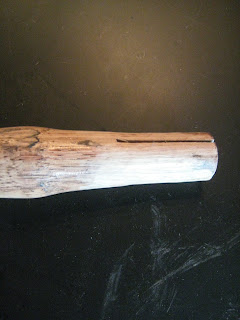We've had a drip in the kitchen faucet for months now. It's one of those things that isn't a major emergency to take care of, but never lets you forget that it's a problem.  Before I could work on the faucet, I needed to shut off the water, but because there was no shutoff valve on the hot water line, I had to shut off the water to the whole house. [I may end up installing shutoff valves but the will be a tale for another day]. When I finally took the thing apart I found that the control ball (this is a single lever faucet) was made of brass and had been rubbing against a steel nub for years. This eventually wore a groove into the ball that created slop in it's motion and prevented it from sitting perfectly in the 'off' position.
Before I could work on the faucet, I needed to shut off the water, but because there was no shutoff valve on the hot water line, I had to shut off the water to the whole house. [I may end up installing shutoff valves but the will be a tale for another day]. When I finally took the thing apart I found that the control ball (this is a single lever faucet) was made of brass and had been rubbing against a steel nub for years. This eventually wore a groove into the ball that created slop in it's motion and prevented it from sitting perfectly in the 'off' position.
 Before I could work on the faucet, I needed to shut off the water, but because there was no shutoff valve on the hot water line, I had to shut off the water to the whole house. [I may end up installing shutoff valves but the will be a tale for another day]. When I finally took the thing apart I found that the control ball (this is a single lever faucet) was made of brass and had been rubbing against a steel nub for years. This eventually wore a groove into the ball that created slop in it's motion and prevented it from sitting perfectly in the 'off' position.
Before I could work on the faucet, I needed to shut off the water, but because there was no shutoff valve on the hot water line, I had to shut off the water to the whole house. [I may end up installing shutoff valves but the will be a tale for another day]. When I finally took the thing apart I found that the control ball (this is a single lever faucet) was made of brass and had been rubbing against a steel nub for years. This eventually wore a groove into the ball that created slop in it's motion and prevented it from sitting perfectly in the 'off' position.As it turns out, my faucet was a Delta compatible style faucet that meant that it had a standard set of replacement parts. I took the damaged control ball down to the hardware store and the plumbing people handed me this little baggie of replacement parts. Fortunately, they now make the control ball out of stainless steel.
Since I got a full set of new parts, I just went ahead and replace the whole mechanism. There are two little spring loaded rubber gaskets that sit over openings where the hot and cold water come into the faucet head that I replaced. Then the ball, and finally this nylon retainer. Another problem was that the notch in the faucet base that is used to keep the nylon retainer properly aligned had become malformed and was preventing the old retainer from seating. I reshaped the notch with a small file to allow the new retainer to sit all the way down onto the control ball.
And now I can sleep at night knowing that I'm not wasting any more water!




































